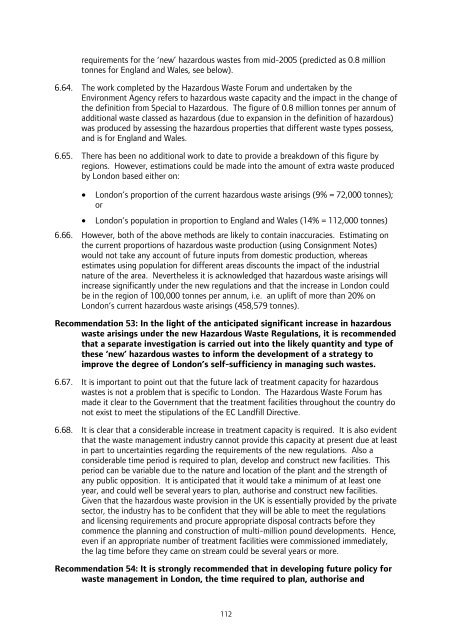London Wider Waste Strategy - London - Greater London Authority
London Wider Waste Strategy - London - Greater London Authority
London Wider Waste Strategy - London - Greater London Authority
Create successful ePaper yourself
Turn your PDF publications into a flip-book with our unique Google optimized e-Paper software.
equirements for the ‘new’ hazardous wastes from mid-2005 (predicted as 0.8 million<br />
tonnes for England and Wales, see below).<br />
6.64. The work completed by the Hazardous <strong>Waste</strong> Forum and undertaken by the<br />
Environment Agency refers to hazardous waste capacity and the impact in the change of<br />
the definition from Special to Hazardous. The figure of 0.8 million tonnes per annum of<br />
additional waste classed as hazardous (due to expansion in the definition of hazardous)<br />
was produced by assessing the hazardous properties that different waste types possess,<br />
and is for England and Wales.<br />
6.65. There has been no additional work to date to provide a breakdown of this figure by<br />
regions. However, estimations could be made into the amount of extra waste produced<br />
by <strong>London</strong> based either on:<br />
• <strong>London</strong>’s proportion of the current hazardous waste arisings (9% = 72,000 tonnes);<br />
or<br />
• <strong>London</strong>’s population in proportion to England and Wales (14% = 112,000 tonnes)<br />
6.66. However, both of the above methods are likely to contain inaccuracies. Estimating on<br />
the current proportions of hazardous waste production (using Consignment Notes)<br />
would not take any account of future inputs from domestic production, whereas<br />
estimates using population for different areas discounts the impact of the industrial<br />
nature of the area. Nevertheless it is acknowledged that hazardous waste arisings will<br />
increase significantly under the new regulations and that the increase in <strong>London</strong> could<br />
be in the region of 100,000 tonnes per annum, i.e. an uplift of more than 20% on<br />
<strong>London</strong>’s current hazardous waste arisings (458,579 tonnes).<br />
Recommendation 53: In the light of the anticipated significant increase in hazardous<br />
waste arisings under the new Hazardous <strong>Waste</strong> Regulations, it is recommended<br />
that a separate investigation is carried out into the likely quantity and type of<br />
these ‘new’ hazardous wastes to inform the development of a strategy to<br />
improve the degree of <strong>London</strong>’s self-sufficiency in managing such wastes.<br />
6.67. It is important to point out that the future lack of treatment capacity for hazardous<br />
wastes is not a problem that is specific to <strong>London</strong>. The Hazardous <strong>Waste</strong> Forum has<br />
made it clear to the Government that the treatment facilities throughout the country do<br />
not exist to meet the stipulations of the EC Landfill Directive.<br />
6.68. It is clear that a considerable increase in treatment capacity is required. It is also evident<br />
that the waste management industry cannot provide this capacity at present due at least<br />
in part to uncertainties regarding the requirements of the new regulations. Also a<br />
considerable time period is required to plan, develop and construct new facilities. This<br />
period can be variable due to the nature and location of the plant and the strength of<br />
any public opposition. It is anticipated that it would take a minimum of at least one<br />
year, and could well be several years to plan, authorise and construct new facilities.<br />
Given that the hazardous waste provision in the UK is essentially provided by the private<br />
sector, the industry has to be confident that they will be able to meet the regulations<br />
and licensing requirements and procure appropriate disposal contracts before they<br />
commence the planning and construction of multi-million pound developments. Hence,<br />
even if an appropriate number of treatment facilities were commissioned immediately,<br />
the lag time before they came on stream could be several years or more.<br />
Recommendation 54: It is strongly recommended that in developing future policy for<br />
waste management in <strong>London</strong>, the time required to plan, authorise and<br />
112
















